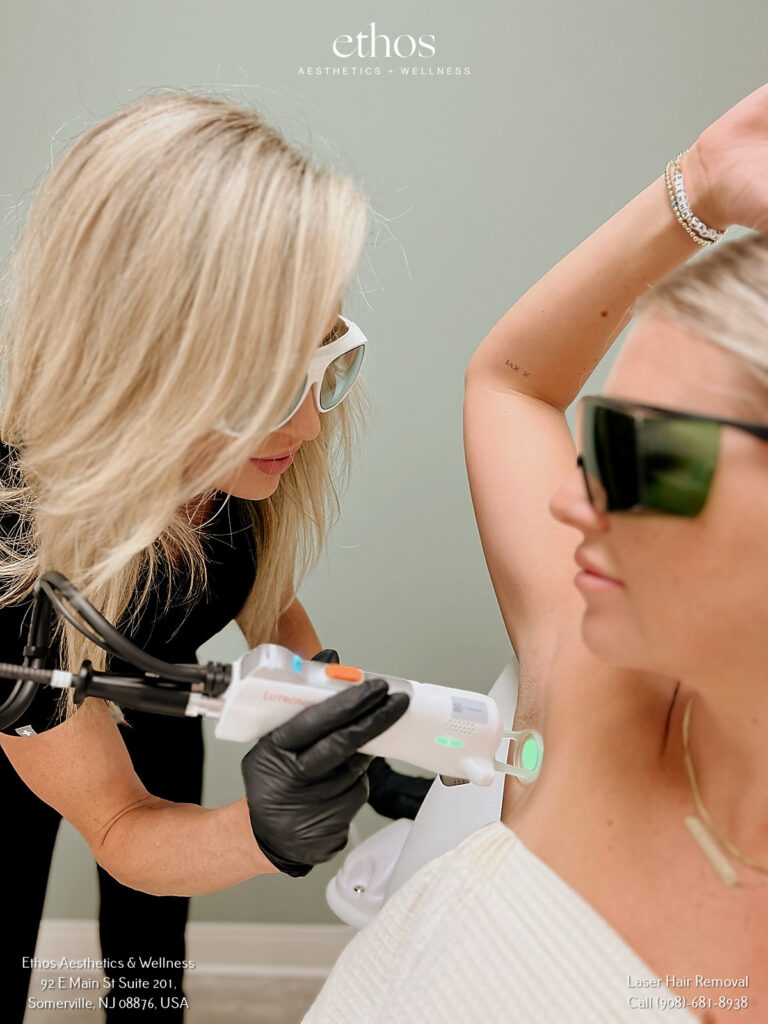Not Seeing Results After Laser Hair Removal? Here’s Why
Laser hair removal is a popular cosmetic treatment that uses concentrated beams of light to selectively target and disable hair follicles.
When performed correctly, laser hair removal can permanently reduce unwanted hair growth and free people from the hassle of shaving or waxing.
However, results vary from person to person. You may be frustrated if you undergo a series of laser hair removal sessions but don’t see the long-lasting hair reduction you expected.
Several factors influence the efficacy and permanence of laser hair removal results. By understanding the elements that impact success, you can take steps to set yourself up for the best outcome or troubleshoot lackluster results.
What Are the Signs of a Failed Laser Hair Removal Treatment?

Signs of a failed laser hair removal treatment can manifest in various ways and may require attention to determine the next steps:
- Persistent Hair Regrowth: If you notice that your hair is growing back at the same rate and thickness as before treatment, it might indicate that the laser has not effectively targeted the hair follicles.
- Extended Skin Irritation: While some redness and swelling are normal immediately after treatment, prolonged irritation could suggest an adverse reaction or improper laser use.
- Pigmentation Changes: Any significant darkening or lightening of the treated skin area that persists could be a sign of improper laser settings or technique.
- Altered Skin Texture: If the texture of your skin changes, especially after recent sun exposure, it might be a reaction to the laser treatment.
- Scarring: Although rare when treatments are performed correctly, the presence of scars may indicate that the skin has not responded well to the laser.
- Blisters and Skin Crusting: These can occur if the treated area is not adequately cared for post-treatment or exposed to the sun prematurely.
- Paradoxical Hypertrichosis: In some cases, laser treatment may stimulate hair to grow denser and thicker in the treated area, which is the opposite of the desired outcome.
What Are the Expected Outcomes of Laser Hair Removal?
Laser hair removal, using selective photothermolysis, targets hair follicles with light pulses absorbed by melanin. This process turns light into heat, damaging follicles and reducing their hair regeneration capacity.
For best results, 6-8 sessions, 4-6 weeks apart, are generally needed. This is because the treatment only affects actively growing hairs, and not all hairs grow simultaneously.
On average, this method can lead to up to a 90% permanent reduction in hair, with any remaining hairs often being lighter and finer. The effectiveness varies based on individual hair and skin characteristics.
Why Might Someone Not See Results After Laser Hair Removal?
There are a few key reasons you may not see satisfactory hair removal results after completing laser treatments:
Hair and Skin Type
Laser hair removal works best on individuals with fair skin and dark coarse hair. The light energy targets melanin pigment in hair follicles, so lighter hair has less pigment to absorb the laser.
Hair Growth Cycle
Laser can only disable follicles in the active growth phase. If too many follicles are dormant, fewer hairs will be treated with each session. More sessions may be needed to catch all follicles when active.
Improper Laser Settings
Laser technicians must properly adjust settings like wavelength, fluence, and pulse duration based on your skin type and hair thickness. Suboptimal settings can fail to sufficiently heat and disable follicles.
Pre and Post Treatment Care
Not adhering to pre and post-treatment protocols can interfere with results. For example, sun exposure makes laser treatment less effective and increases risks.
Hormonal Changes
Fluctuations in hormones like estrogen and testosterone can disrupt hair growth patterns and spur new growth, impacting the longevity of laser hair removal results.
Unrealistic Expectations
While laser hair removal can provide lasting hair reduction, it usually does not result in 100% permanent hair removal. Managing expectations is key.
How Does Skin Tone Affect Laser Hair Removal Efficacy?
Skin tone plays a major role in the safety and efficacy of laser hair removal treatments.
Lasers work by targeting melanin, the pigment that gives hair and skin their color. Melanin occurs in higher concentrations in darker skin and hair.
Individuals with fair skin and dark hair tend to see the best results with laser hair removal. The high melanin content in their hair allows for optimal laser absorption and destruction of follicles.
At the same time, their low melanin skin avoids unwanted absorption of laser energy into the skin, preventing discomfort, blistering, or discoloration.
For patients with darker skin tones, laser technicians must adjust settings and use longer wavelengths that penetrate deeper to target hair follicles beneath the epidermis.
Can Hair Color Influence the Success of Laser Hair Removal?
The color of your hair directly impacts how well it will absorb laser energy and determine the success of laser hair removal. Lasers work by selectively targeting melanin in hair follicles while avoiding damage to surrounding skin.
Melanin gives hair its color, occurring in the highest concentrations in black and brown hair. Blonde, gray, and red hair have very low melanin content. With less pigment to absorb the laser, blonde and red hair respond poorly to laser hair removal.
Even dark brown hair has more melanin than light brown or blonde hair, making it better suited for laser elimination.
At Ethos Aesthetics, Dr. Soni may advise dark-haired patients with blonde patches or grays that those areas may require more treatments for a reduction in growth.
What Role Does Hair Thickness Play in Laser Hair Removal Success?
Hair thickness significantly influences the effectiveness of laser hair removal treatments. Thick, coarse hair generally responds better to laser treatment compared to fine, thin hair. This difference in response is due to the distinct characteristics of hair types.
The Hair Growth Phases and Laser Treatment
Hair undergoes three main growth phases:
- Anagen (active)
- Catagen (transition)
- Telogen (resting)
Thick terminal hairs, often found in areas like the legs and underarms, spend a longer duration in the anagen phase compared to fine vellus hairs, typically seen on areas like the face.
Since laser treatments are most effective on hairs in the anagen phase, thick hair, which stays longer in this stage, is more likely to be successfully treated.
Melanin Content in Thick vs. Thin Hair
Another factor is the melanin content in different hair types. Thick, dark hairs have more melanin compared to thin, light hairs. Lasers target this melanin to deliver thermal damage to hair follicles.
Therefore, the higher melanin content in thick hair enhances the absorption of laser pulses, leading to more effective follicle damage.
Effectiveness on Fine Hair
People with fine, light hair might notice that laser treatment primarily reduces hair growth rather than completely eliminating it. While some reduction in hair growth can be achieved, complete removal is less likely compared to the results seen in thick, dark hair.
Is There a Best Time in the Hair Growth Cycle for Laser Hair Removal?
For laser hair removal to be effective, hair follicles must be treated while in the active growth phase known as anagen. During anagen, the hair bulb and root are energized and contain ample melanin to absorb laser energy.
The anagen phase lasts 3-5 years for hair on the scalp but just 4-10 weeks for body hair before transitioning to the dormant catagen and telogen phases. Catching body hair during its brief active growth window is crucial for the disruption of hair regrowth by laser treatment.
At Ethos Aesthetics, Dr. Soni spaces laser sessions 4-6 weeks apart to make sure we re-treat hairs that were dormant during the previous visit and hit them in their early anagen stage.
By timing treatments around the hair growth cycle, our laser hair removal clients see optimal reductions in hair regrowth after just 6-8 sessions.
How Can Hormonal Changes Impact the Results of Laser Hair Removal?
Hormones like estrogen, progesterone, and testosterone all influence hair growth patterns in complex ways. Changes in hormone levels over time can disrupt treatment outcomes after laser hair removal procedures.
Estrogen is linked with fine vellus hair growth, while testosterone triggers thicker, darker terminal hairs. Normal shifts in the body’s hormonal milieu during events like menstruation, pregnancy, and menopause impact the types of hair being produced.
These hormonal fluctuations may stimulate new hair growth, potentially from follicles not previously active. Freshly roused follicles can escape the laser disruption aimed at their neighboring follicles and continue growing hair.
For optimal laser hair removal results, maintaining hormone balance is ideal. However, even with hormonal changes, repeating treatments every year or two can catch newly activated follicles and preserve hair removal. Dr. Soni advises patients on strategies to minimize unwanted hair growth between sessions.
What Are the Common Mistakes People Make With Laser Hair Removal?
Laser hair removal provides excellent hair reduction when performed correctly over a series of treatments. However, some common mistakes can sabotage your results:
- Shaving Instead of Waxing Between Sessions – Shaving leaves hairs with a blunt tip that won’t absorb laser energy as effectively as waxed hairs.
- Sun Exposure Before Treatment – Recent tanning makes skin more susceptible to laser burns and reduces hair removal efficacy.
- Skipping Post-Treatment Care – Failing to soothe skin or avoid sun exposure can lead to discomfort, blistering, and pigment changes.
- Unrealistic Expectations – Laser hair removal doesn’t guarantee 100% permanent hair loss; managing expectations prevents disappointment.
- Interval Between Treatments Too Long – Stretching sessions too far apart allows hair to enter dormant phases and avoid disruption.
To prevent these issues, Dr. Soni provides detailed pre- and post-care instructions to our laser hair removal patients at Ethos Aesthetics. We emphasize strict sun avoidance, waxing between treatments, and top-notch skin care for optimal results from our laser technology.
Could the Choice of Laser Technology Make a Difference?
The effectiveness of laser hair removal largely depends on the type of laser used. Different lasers emit varying wavelengths, which affects their ability to target melanin in hair follicles.
For example, studies show that Diode lasers, for example, are often more effective than home-use lasers in reducing hair, due to their specific wavelength that precisely targets and impacts hair follicles for better hair reduction results.
What Should Be Done If Laser Hair Removal Is Not Working?
If you complete your initial laser hair removal sessions but do not see the amount of hair reduction you expected, don’t lose hope. Here’s what you can do:
- Schedule a Follow-up Consultation: Book another appointment with your dermatologist or laser specialist if initial laser hair removal sessions are not effective.
- Assessment of Factors Influencing Effectiveness: Have a discussion about hair color, thickness, growth patterns, and hormone status, as these can all affect laser hair removal efficacy.
- Consideration of Alternative Laser Options: The specialist may recommend changing to a different laser wavelength more compatible with your hair and skin type or using a laser with a larger spot size for better results.
- Adjustment of Treatment Intervals: Consider spacing out sessions every 10-12 weeks to better accommodate major hormonal fluctuations that could affect hair growth.
- Check Your Hair Removal Routine: Ensure you are not waxing between sessions, avoiding sun exposure, and using topical creams as directed for optimal laser effectiveness.
- Setting Realistic Expectations: Understand that laser hair removal usually results in significant hair reduction but not 100% permanent removal and that ongoing touch-up sessions may be necessary.
Takeaway
Laser hair removal isn’t an instant solution for your hairy problems. Factors like hair color, skin type, hair thickness, hormones, and following pre and post-care matter.
If you’re not happy with your results, talk to your specialist. They’ll adjust your plan for better results.
With the right approach, you can reduce hair growth and enjoy smoother skin. At Ethos Aesthetics, Dr. Soni and his team are here to help you get the results you want.
Explore Safe and Effective Laser Hair Removal with Dr. Soni at Ethos Aesthetics + Wellness

Experience the pinnacle of laser hair removal at Ethos Aesthetics + Wellness, where Dr. Soni and our dedicated team prioritize your safety and satisfaction.
Choose confidence, choose Ethos Aesthetics + Wellness for your laser hair removal needs—where your well-being is our ultimate commitment.
Contact us today to learn more about our personalized treatments and how we can help you achieve the best possible results.
FAQs About Laser Hair Removal – Addressing Your Concerns
What should I do if I experience excessive swelling or blistering after a treatment?
Post-treatment swelling and discomfort are expected, but significant swelling or blistering requires immediate attention. Contact your treatment provider for advice on managing these symptoms. They might suggest a cold compress and over-the-counter medication. If conditions worsen, seek medical attention.
The laser missed some spots – can I treat them myself at home?
Home treatment for missed spots after laser hair removal is not advisable. Professional treatments involve specialized equipment that requires training for safe use. If spots were missed, contact your provider to discuss a follow-up treatment. Self-treatment could result in skin damage.
What should I expect if I get laser hair removal while on my period?
Undergoing laser hair removal during menstruation may increase skin sensitivity, discomfort, and the duration of swelling. If you choose to proceed with treatment during this time, be aware of a potentially higher risk of side effects. It’s best to consult with your provider before making a decision.
The hair is growing back faster/thicker after laser – why?
Occasionally, laser hair removal might inadvertently stimulate more vigorous hair growth. This could be due to the type of hair, inappropriate laser settings, or underlying health issues. If you notice this, reach out to your provider to reevaluate your treatment plan or consider an alternative hair removal method.
How do I choose a reputable laser hair removal provider?
To minimize risks, ensure the clinic adheres to safety standards:
- Qualified Personnel: Only licensed medical professionals should perform procedures.
- Approved Equipment: Clinics should use FDA-approved lasers and conduct a skin assessment before treatments.
- Expertise: Look for a clinic with experience treating your specific skin type and hair location.
- Staff Credentials: Verify that the clinic’s staff are continuously trained and certified.
What immediate actions should I take if I experience adverse effects?
If you encounter severe side effects, act swiftly:
- Intense Pain: If treatment causes extreme pain, seek medical attention without delay.
- Skin Damage: For blistering or sores, consult a healthcare provider promptly.
- Signs of Infection: Fever, increased pain, swelling, or pus should be evaluated by a medical professional immediately.
- Legal Advice: In case of significant issues, consider speaking with a legal expert about potential compensation.
How can I avoid complications post-laser hair removal?
Effective aftercare is crucial for a good outcome:
- Skin Care: Keep the treated area clean and apply prescribed ointments.
- Sun Protection: Avoid direct sunlight and heat on the treated areas to prevent pigment changes.
- Vigilance: Monitor for infection signs and reach out to your provider if you have concerns.







